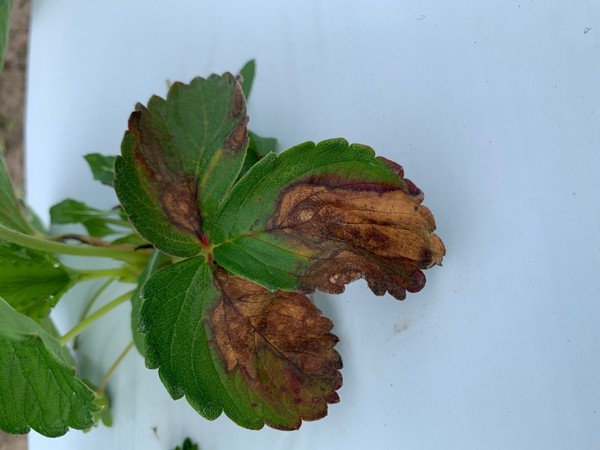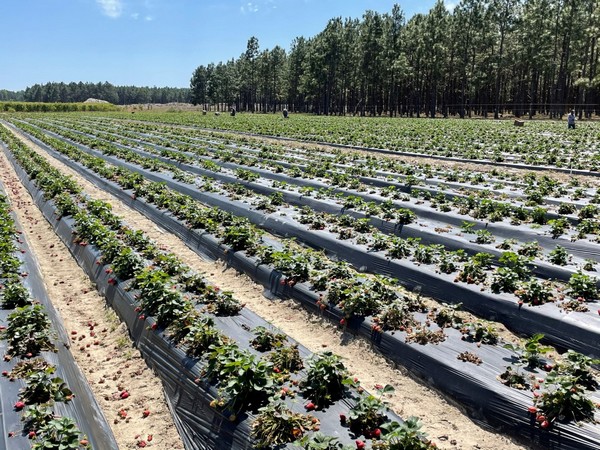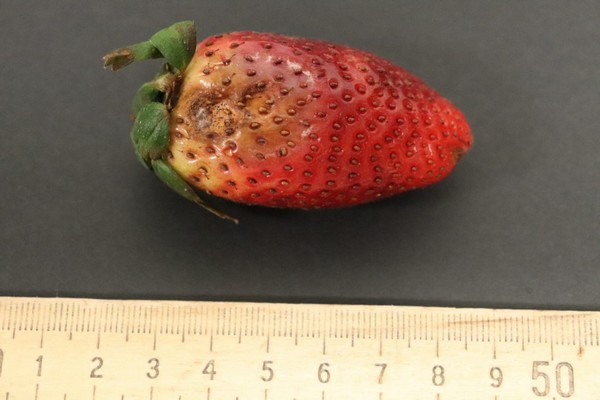Apr 23, 2021Florida strawberry growers concerned due to Neopestalotiopsis fruit rot disease
Pestalotiopsis-like species have been reported affecting strawberry worldwide. Recently, severe and unprecedented outbreaks have been reported in Florida commercial fields where leaf, fruit, petiole, crown, and root symptoms were observed and yield was severely affected.
The taxonomic status of the fungus is confusing because it has gone through multiple reclassifications over the years. Morphological characteristics, phylogenetic analyses, and pathogenicity tests were evaluated for strawberry isolates recovered from diseased plants in Florida.
Phylogenetic analyses derived from the combined internal transcribed spacer, β-tub, and tef1 regions demonstrated that although there was low genetic diversity among the strawberry isolates, there was a clear separation of the isolates in two groups. The first group included isolates recovered over a period of several years, which was identified as Neopestalotiopsis rosae.
Most isolates recovered during the recent outbreaks were genetically different and may belong to a new species. On potato dextrose agar, both groups produced white, circular, and cottony colonies. From the bottom,colonies were white to pale yellow for Neopestalotiopsis sp. and pale luteous to orange for N. rosae. Spores for both groups werefive-celled with three median versicolored cells. Mycelial growth and spore production were higher for thenew Neopestalotiopsis sp. isolates. Isolates from both groups were pathogenic to strawberryroots and crowns. However, the new Neopestalotiopsis sp. proved more aggressive in fruit and leaf inoculation tests, confirming observations from the recent outbreaks in commercial strawberry fields in Florida.

Fungal disease has been and continues to be a problem for crop growers worldwide every year. Some diseases stick around for decades, while others come and go from year to year. Neopestalotiopsis, sometimes referred to as Pestalotpsis by researchers, is a fungal pathogen that has come and gone throughout the years but has made a re-appearance in Florida strawberry production in recent years. So, what is Neopestalotiopsis and what do you need to know about it?
Neopestalotiopsis is a fungal disease that affects strawberries and many other crops. It was first discovered in Florida strawberry production in the early 1970’s and then again in 2012. However, it did not pose a large threat to Florida strawberry production until it entered the market in 2018, where it started to cause considerable losses for growers.
According to research done at the University of Florida, the fungus’ primary source is from infected transplants coming in from nurseries. Once established, the disease can spread to neighboring fields. For the last few seasons, the presence of Neopestalotiopsis in Florida strawberry fields has been so severe that entire fields have been left without being harvested and large quantities of fruit have been wasted. Originally thought of just a fruit rotting disease, Neopestalotiopsis attacks all parts of the plant, including the roots, crown, leaves and fruit.
An article by The University of Florida IFAS Extension describes symptoms of the pathogen from their research. They emphasize that Neopestalotiopsis, which they refer to as Pestalotpsis, is most common to cause symptoms on strawberries’ crowns and roots during establishment. These symptoms include “darkening of the roots and orange-brown necrosis in the crowns” causing poor establishment and stunting after transplanting. In addition to below-ground symptoms, there are also above-ground symptoms such as wilting, leaf spotting, blight, and stunting. Eventually, the fungus spreads to the fruit and causes it to rot as well.

Another problem with the increasingly prevalent pathogen is that growers are very limited to what fungicides they can use, as many on the market are unable to control the spread. However, there may be other ways to battle this disease in your operation. A recent study from Florida Ag Research on Neopestalotiopsis revealed some more information regarding the pest. This study suggests a higher severity of Neopestalotiopsis in areas where there was reported feeding from Two Spotted Spider Mites.
This correlation between insect feeding and higherdisease presence is not uncommon in production. An abstract from the book Insects in relation to plant disease mentions the symbiotic relationship between fungalinfection and insect feeding. Plants weakened by fungal infections are also prime targets for insects to prey on.
Because of this phenomenon, it is even more important to control insect pressure on your operation. Keeping harmful insects off your plants with frequent scouting and monitoring can contribute to your operation’s success by keeping the plants as healthy as possible to stand up to other stressors.
An excellent way to do this is to spray a miticide-insecticide.

















